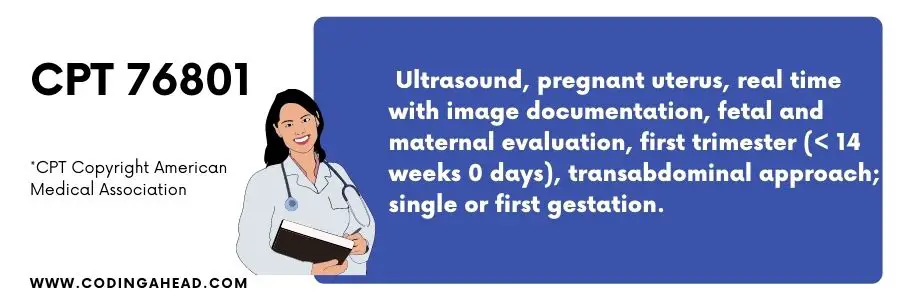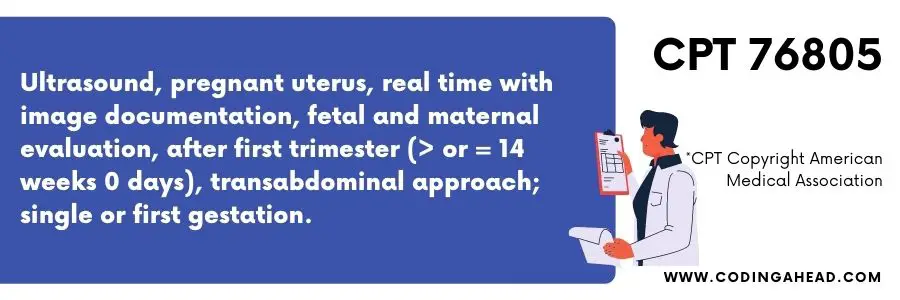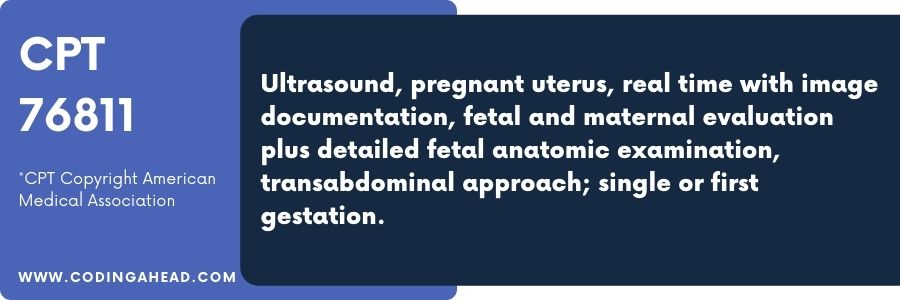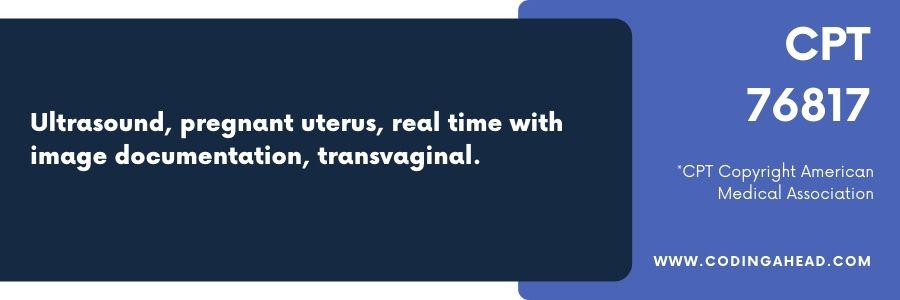(2022) How To Code Ultrasound In Pregnancy (CPT Codes & Billing Guidelines)
Ultrasound in pregnancy can be billed with CPT 76801 (Standard first trimester ultrasound), CPT 76805 (Standard second or third trimester ultrasound), CPT 76811 (Detailed anatomic ultrasound) and CPT 76817 (Transvaginal ultrasound).
This policy outlines the medical necessity criteria for ultrasound use in pregnancy. Ultrasound is the most common fetal imaging tool used today.
Ultrasound is accurate at determining gestational age, fetal number, viability, and placental location; and is necessary for many diagnostic purposes in obstetrics.
The determination of the time and type of ultrasound should allow for a specific clinical question(s) to be answered. Ultrasound exams should be conducted only when indicated and must be appropriately documented.
CPT Codes For Ultrasound in Pregnancy
It is the policy of health plans affiliated with Centene Corporation that the following
ultrasounds during pregnancy are considered medically necessary when the following conditions are met.
I. Standard first trimester ultrasound (CPT 76801)
II. Standard second or third trimester ultrasound (CPT 76805)
III. Detailed anatomic ultrasound (CPT 76811)
IV. Transvaginal ultrasound (CPT 76817)
V. Not medically necessary conditions
CPT Code 76801
One standard first trimester ultrasound (CPT 76801) is allowed per pregnancy.
Subsequent standard first trimester ultrasounds are considered not medically necessary as a limited or follow-up ultrasound assessment (CPT 76815 or CPT 76816) should be sufficient to provide a re-examination of suspected concerns.

Before 14 weeks and 0 days of gestation. CPT code 76801 can be performed transabdominally, transvaginally, or transperineally.
When performed transvaginally, CPT 76817 should be used. It includes an evaluation of the presence, size, location, and number of gestational sac(s); and an evaluation of the gestational sac(s).
Indications for a first trimester ultrasound include the following:
- To confirm an intrauterine pregnancy
- To evaluate a suspected ectopic pregnancy
- To evaluate vaginal bleeding
- To evaluate pelvic pain
- To estimate gestational age
- To diagnose and evaluate multiple gestations
- To confirm cardiac activity
- As adjunct to chorionic villus sampling, embryo transfer, or localization and removal of an intrauterine device
- To assess for certain fetal anomalies, such as anencephaly, in high risk patients
- To evaluate maternal pelvic or adnexal masses or uterine abnormalities
- To screen for fetal aneuploidy (nuchal translucency) when a part of aneuploidy screening
- To evaluate suspected hydatidiform mole
CPT Code 76805
76805 CPT Code Description: One standard second or third trimester ultrasound (CPT 76805) is allowed per pregnancy.
Subsequent standard second or third trimester ultrasounds are considered not medically necessary as a limited or follow-up ultrasound assessment (CPT 76815 or CPT 76816) should be sufficient to provide a re-examination of suspected concerns.

A standard ultrasound in the second or third trimester involves an evaluation of fetal presentation and number, amniotic fluid volume, cardiac activity, placental position, fetal biometry, and an anatomic survey.
Indications for a standard second or third trimester ultrasound include the following:
- Screening for fetal anomalies
- Evaluation of fetal anatomy
- Estimation of gestational age
- Evaluation of fetal growth
- Evaluation of vaginal bleeding
- Evaluation of cervical insufficiency
- Evaluation of abdominal and pelvic pain
- Determination of fetal presentation
- Evaluation of suspected multiple gestation
- Adjunct to amniocentesis or other procedure
- Evaluation of discrepancy between uterine size and clinical dates
- Evaluation of pelvic mass
- Examination of suspected hydatidiform mole
- Adjunct to cervical cerclage placement
- Evaluation of suspected ectopic pregnancy
- Evaluation of suspected fetal death
- Evaluation of suspected uterine abnormality
- Evaluation of fetal well-being
- Evaluation of suspected amniotic fluid abnormalities
- Evaluation of suspected placental abruption
- Adjunct to external cephalic version
- Evaluation of prelabor rupture of membranes or premature labor
- Evaluation for abnormal biochemical markers
- Follow-up evaluation of a fetal anomaly
- Follow-up evaluation of placental location for suspected placenta previa
- Evaluation with a history of previous congenital anomaly
- Evaluation of fetal condition in late registrants for prenatal care
- Assessment for findings that may increase the risk of aneuploidy
CPT Code 76811
76811 CPT Code Description: One detailed anatomic ultrasound (CPT 76811) is allowed per pregnancy when performed to evaluate for suspected anomaly based on history, laboratory abnormalities, or clinical evaluation; or when there are suspicious results from a limited or standard ultrasound.

Further indications include the possibility of fetal growth restriction and multifetal gestation. This ultrasound must be billed with an appropriate high risk diagnosis code.
A second detailed anatomic ultrasound is considered medically necessary if a new maternal fetal medicine specialist group is taking over care, a second opinion is required, or the patient has been transferred to a tertiary care center in anticipation of delivery of an anomalous fetus requiring specialized neonatal care.
Further anatomic ultrasounds are considered not medically necessary as there is inadequate evidence of the clinical utility of multiple detailed fetal anatomic examinations.
A detailed anatomic ultrasound is performed when there is an increased risk of an anomaly based on the history, laboratory abnormalities, or the results of the limited or standard ultrasound.
CPT Code 76817
76817 CPT Code Description: Transvaginal ultrasounds/TVU (CPT 76817) are considered medically necessary when conducted in the first trimester for the same indications as a standard first trimester ultrasound, and later in pregnancy to assess cervical length, location of the placenta in women with placenta previa, or after an inconclusive transabdominal ultrasound.

Cervical length screening is conducted for women with a history of preterm labor or to monitor a shortened cervix based on below information.
Up to 12 transvaginal ultrasounds are allowed per pregnancy.
Berghella approach to TVU measurement of cervical length for screening singleton gestations
A transvaginal ultrasound of a pregnant uterus can be performed in the first trimester of pregnancy and later in a pregnancy to evaluate cervical length and the position of the placenta relative to the internal cervical os.
When this exam is done in the first trimester, the same indications for a standard first trimester ultrasound, CPT 76801.
Past Pregnancy History
1. Prior preterm birth, 14 to 27 weeks
2. Prior preterm birth 28 to 36 weeks
3. No prior preterm birth
TVU Cervical Length Screening
1. Start at 14 weeks and end at 24 weeks
2. Start at 16 weeks and end at 24 weeks
3. One exam between 18 and 24 weeks
Frequency
1. Every 2 weeks as long as cervix is at least 30 mm*
2. Every 2 weeks as long as cervix is at least 30 mm*
3. Once
Maximum # Of TVU
1. 6
2. 5
3. 1
* Increase frequency to weekly in women with TVU cervical length of 25 to 29 mm. If <25 mm before 24 weeks, consider cerclage.
Not Medically Necessary Procedures
3D and 4D ultrasounds are considered investigational and are therefore not medically necessary.
Studies lack sufficient evidence that they alter management over two dimensional ultrasound in a fashion that improves outcomes.
The following additional procedures are considered not medically necessary:
- Ultrasounds performed solely to determine the sex of the fetus or to provide parents with photographs of the fetus;
- Scans for growth evaluation performed less than 2 weeks apart;
- Ultrasound to confirm pregnancy in the absence of other indications;
- A follow-up ultrasound in the first trimester in the absence of pain or bleeding.


